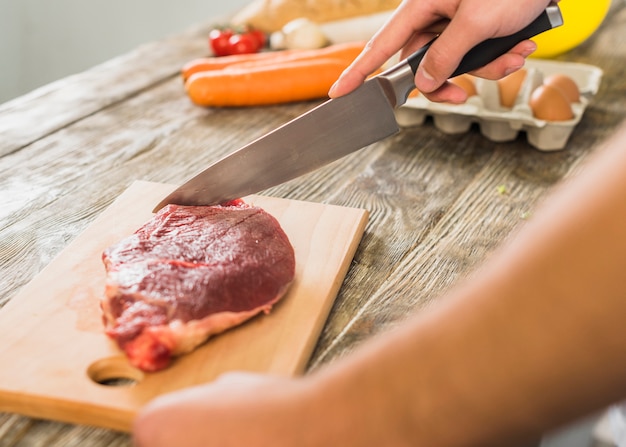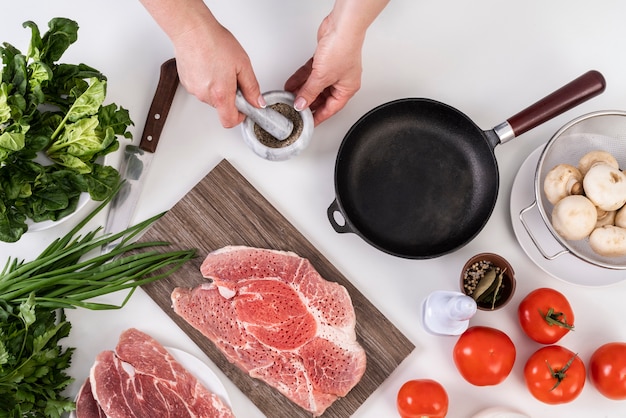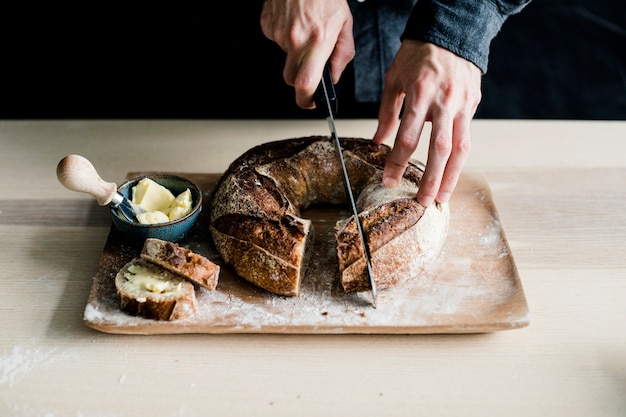You've got the grill fired up, the aroma of smoke fills the air, and you're ready to tackle that juicy steak. But hold on, my friend! A perfectly cooked medium-well steak isn't just about throwing it on the grill and hoping for the best. It's about understanding the nuances of heat, timing, and the little details that make all the difference. Let's dive in and unlock the secrets to creating a steak that's both flavorful and tender, a symphony of flavors that will make you the envy of every barbecue enthusiast.
(Part 1) choosing the right cut: A Foundation for Success

It all starts with choosing the right cut of beef. Just like a skilled carpenter needs the right tools, we need the right foundation to build upon. We're aiming for a steak that can handle the heat and hold its shape, a cut with enough marbling to deliver juiciness and a bit of that delicious, melt-in-your-mouth texture.
Why Some Cuts Are Made for Medium-Well: Unveiling the Secrets
Here's the thing about medium-well done: it requires a bit more cooking time. That longer cook can turn some cuts dry and tough, like a well-meaning but overcooked piece of chicken. We want to avoid that, so we're looking for cuts with a little more muscle, a bit more marbling, and some connective tissue to break down during cooking. The marbling adds flavor and juiciness, while the connective tissue softens, transforming those tough fibers into a symphony of tender bites.
The Champions of Medium-Well: Your steak selection Guide
Now, let's get down to brass tacks. Here are some of the best cuts for achieving that perfect medium-well:
- Sirloin: It's a classic for a reason, mate. It's got a beautiful balance of flavor and tenderness, and it holds up well to a bit more cooking. Think of it as the reliable friend you can always count on.
- Top Sirloin: A close relative of its famous cousin, top sirloin is a bit leaner but still delivers a fantastic flavor. It's a bit more budget-friendly, making it a great choice when you want to impress without breaking the bank.
- flank steak: Don't let the name fool you, flank steak is packed with flavor. It's a bit tougher, but with the right cooking technique, it can be tender and incredibly satisfying. It's like a diamond in the rough, waiting to be polished.
- chuck steak: This cut is bursting with flavor, but it needs a bit more time to break down those tough fibers. It's fantastic for braising, but it can also be pan-fried or grilled to a juicy medium-well. It's a real workhorse in the kitchen, ready to take on any challenge.
- round steak: This is a bit of a hidden gem. It's a leaner cut, but with proper cooking, it can be surprisingly tender. It's a great option when you're looking for a budget-friendly choice that doesn't compromise on flavor.
(Part 2) Understanding Medium-Well Done: Unlocking the Mystery

Alright, you've got your cut of beef. Now, let's talk about what we actually mean by "medium-well done." It's that sweet spot where the steak is cooked through and holds its shape but still retains a hint of that enticing pinkness in the center. Think of it as the happy medium, the perfect balance between doneness and tenderness.
Beyond Visuals: Delving into the Science of Doneness
Medium-well done isn't just about how it looks, though. It's about the internal temperature, that crucial metric that tells us exactly how far the cooking process has gone. We're aiming for an internal temperature of 145°F to 150°F (63°C to 66°C). This ensures that the steak is cooked through and safe to eat, while still preserving some of that juicy pinkness and tenderness.
The Touch Test: A Guide for the Experienced
Now, if you're a seasoned grill master, you might be familiar with the "touch test." It's a bit of a feel thing, where you press on the center of your steak and gauge its firmness. If it feels firm but gives a little, it's likely medium-well. But be warned, this method is more of a guide than a guarantee. It's best to rely on a meat thermometer for accurate results, especially if you're new to the grill.
(Part 3) Preparing Your Steak for the Grill: Setting the Stage for Success

Your steak is chosen, you understand the target, now it's time to get ready for the grilling action. A little bit of preparation goes a long way in ensuring a perfectly cooked steak.
Room Temperature: The Key to Even Cooking
Think of it this way: a cold steak is like a shy guest at a party. It takes a while to warm up and join the fun. Bring your steak to room temperature before grilling. This allows the steak to cook more evenly, resulting in a juicier and more tender outcome. It's a simple step, but it makes a world of difference.
Patting Dry: Avoiding Unwanted Steaming
Next, you'll want to pat your steak dry with paper towels. This removes any excess moisture, preventing the steak from steaming instead of searing. A good sear is the foundation of a perfect steak, creating that delicious crust that traps in flavor and moisture.
Seasoning Wisely: Keeping it Simple, Yet Effective
Now, this is where some folks go a bit overboard. The truth is, you don't need to drown your steak in a bunch of fancy spices. Salt and pepper are your best friends. I like to use kosher salt, because its larger grains stick to the steak better. Black pepper adds that classic bite, but feel free to add a touch of your favorite spices. Just be sure to season liberally and on both sides, so every part of the steak gets that flavor boost.
(Part 4) Grilling Your Steak to Perfection: The Grand Performance
Finally, the moment you've been waiting for! The grill is ready, the smoke is swirling, and your steak is prepped and ready to be a star.
Heating Up: Setting the Right Stage
Start by preheating your grill to medium-high heat, around 400°F (200°C). You want the grill hot enough to create a beautiful sear without burning the steak. If you're using a gas grill, make sure all the burners are preheated. If you're using a charcoal grill, get those coals evenly distributed and covered with a layer of ash.
Mastering the Grill: Direct vs. Indirect Heat
Now, here's where the real magic happens. For a medium-well steak, you're going to want to use a combination of direct and indirect heat. Start by placing your steak directly over the hottest part of the grill. This will give you that delicious sear, quickly cooking the outside and creating a flavorful crust.
The Sear: A Culinary Masterpiece
Think of the sear as the opening act, setting the stage for the main event. You want to sear each side for about 2-3 minutes to get that beautiful, caramelized crust. Remember, you're not trying to cook the steak all the way through at this stage, just get that initial sear going.
Indirect Heat: Finishing the Show
Once your steak has that beautiful crust on both sides, it's time to move it to the indirect heat zone, or a cooler part of the grill. This allows the steak to cook through evenly without burning the outside. Think of it as the final act, where the steak takes center stage and reaches its full potential.
Grilling Time: A Guide to Success
The exact grilling time will vary depending on the thickness of your steak and the heat of your grill. A thicker steak will need more time, and a hotter grill will cook it faster. Keep a watchful eye on your steak and use a meat thermometer to check the internal temperature. As a general guide, a 1-inch thick steak will take around 5-7 minutes per side.
(Part 5) The Resting Period: Allowing the Steak to Relax
You've seared it, you've cooked it, it's looking perfect, but don't be tempted to dive in just yet! Let that steak rest for 5-10 minutes before slicing and serving. This gives the juices a chance to redistribute throughout the steak, creating a more tender and juicy bite. Cover the steak loosely with foil to keep it warm while it rests.
(Part 6) The Perfect Slice: Mastering the Technique
Your steak is rested and ready to be enjoyed, but there's one last step to ensure that your medium-well steak is truly perfect: the slicing. It might seem like a small detail, but it can make a world of difference.
Against the Grain: Unveiling the Secrets of Tenderness
The muscle fibers in your steak run in a certain direction, known as the "grain." Slicing with the grain can lead to tough, chewy bites. We want to avoid that, so we're going to slice across the grain, breaking down those muscle fibers and making the steak more tender. Think of it as breaking down a puzzle, separating the pieces for a more enjoyable experience.
Thin and Even: A Symphony of Flavors and Visual Appeal
Thin and even slices allow the juices to distribute evenly throughout the steak, creating a more flavorful and satisfying bite. It also looks more appealing on your plate, making your meal a visual masterpiece as well as a culinary one.
(Part 7) The Finishing Touches: Elevating the Flavour
Your steak is cooked, rested, and sliced perfectly. Now, it's time for a little extra flair, a touch of magic that elevates your medium-well steak to the next level.
Butter: A Classic Enhancement
A simple pat of butter is a classic way to add richness and flavor. While your steak is resting, place a pat of butter on top, letting it melt and coat the steak as it rests. You can also add a little bit of herbs, like rosemary or thyme, to the butter for an extra flavor boost. Think of it as a finishing touch, adding a touch of elegance and complexity.
Sauce: The Finishing Touch
A good sauce can elevate your steak to new heights. You can go for a classic like béarnaise, a rich and creamy sauce that pairs beautifully with beef. Or maybe you prefer a more robust option like chimichurri, a vibrant blend of herbs and spices that adds a burst of flavor. The key is to choose a sauce that complements the flavor of your steak, without overpowering it.
side dishes: Complementary Flavors
Don't forget about your side dishes! They can play a big role in balancing the flavor of your steak and making your meal complete. A simple salad or roasted vegetables can be a nice contrast to the richness of the steak. A creamy mashed potato or a hearty baked potato can also be a great accompaniment.
(Part 8) Pan-Frying Your Steak: A Quick and Easy Alternative
Now, I know grilling is the traditional way to cook a steak, but sometimes you just don't have the time or the space for a full-blown grilling session. That's where pan-frying comes in handy. It's a quick and easy way to cook a delicious medium-well steak right on your stovetop.
Choosing the Right Pan: The Foundation for Success
Start by choosing the right pan. Cast iron is a great option, as it heats up quickly and evenly, ensuring a consistent sear. A heavy-bottomed stainless steel pan will also work well. You want a pan that's big enough to hold your steak without overcrowding it, allowing for even cooking.
Heating Your Pan: Setting the Stage for Searing
Heat your pan over medium-high heat. You want the pan to be hot enough to get a good sear on your steak, but not so hot that it burns. Add a little oil to the pan, just enough to coat the bottom. Think of it as a thin layer of lubrication, allowing your steak to glide across the surface without sticking.
Searing and Cooking: The Performance Begins
Once your pan is hot, add your steak to the pan and sear it for about 2-3 minutes per side, or until you get a nice brown crust. Then, reduce the heat to medium and cook for another 3-4 minutes per side, or until the steak reaches your desired level of doneness. Use a meat thermometer to check the internal temperature, ensuring your steak is cooked to perfection.
Resting and Serving: The Encore
After cooking, let your steak rest for 5-10 minutes before slicing and serving. You can add butter, sauce, and side dishes as you would for a grilled steak, completing your culinary masterpiece.
(Part 9) The Ultimate Guide: A Summary
Well, there you have it, the ultimate guide to cooking a perfect medium-well steak. We've covered everything from choosing the right cut to getting that perfect sear, and we've even explored the world of pan-frying. Now, go forth, my friend, and grill those steaks with confidence!
FAQs
Q1: What if I accidentally overcook my steak?
Don't worry, it happens to the best of us! Even the most seasoned grill master has a few overcooked steaks under their belt. If you've overcooked your steak, it's still edible, but it'll be a bit tougher. You can try to salvage it by adding a little bit of sauce or a flavorful rub, hoping to mask the dryness and add a touch of flavor.
Q2: Can I cook a medium-well steak in the oven?
You certainly can! Oven cooking can be a good option for larger cuts of steak, or if you're looking for a more even cook. Preheat your oven to 400°F (200°C) and place your steak on a baking sheet. Cook for about 10-12 minutes per side, or until the steak reaches your desired level of doneness.
Q3: What kind of sauce goes well with a medium-well steak?
That's a matter of personal preference! Some popular choices include béarnaise, a rich and creamy sauce that pairs beautifully with beef. Chimichurri, a vibrant blend of herbs and spices, adds a burst of flavor and freshness. Garlic butter is a classic choice, adding a touch of richness and aroma. Peppercorn sauce offers a spicy kick, while mushroom sauce provides a savory depth. Experiment and find what you like best, creating a unique combination that complements your steak perfectly.
Q4: How do I know if my steak is done without using a thermometer?
You can use the "touch test" as a guide. Press on the center of the steak with your finger. If it feels firm but gives a little, it's likely medium-well done. But remember, this is just a guide. The most reliable way to check the doneness of your steak is with a meat thermometer, especially if you're new to grilling.
Q5: What's the difference between medium-well and well-done steak?
Medium-well done will have some pinkness in the center, while well-done will be cooked all the way through, with no pinkness at all. Medium-well done will also be more tender than well-done, as it's been cooked for a shorter amount of time, preserving some of that juicy, flavorful texture.
Everyone is watching

How to Cook Frozen Lobster Tails Perfectly: A Step-by-Step Guide
RecipesLobster. Just the word conjures up images of lavish meals, special occasions, and a taste of luxury. But let's...

Pigs in a Blanket Cooking Time: How Long to Bake for Perfect Results
RecipesAh, pigs in a blanket. Just the name conjures up images of those delightful little parcels of crispy pastry en...

Pork Fillet Cooking Time: How Long to Cook It Perfectly
RecipesPork fillet, or tenderloin as it's sometimes called, is a real favourite in our house. It's so versatile, and...

The Ultimate Guide to Cooking Delicious Frankfurters
RecipesLet's face it, we all love a good frankfurter. It's a classic, simple, and always satisfying. But let's be rea...

Wolf Meat Recipes: A Guide to Cooking Wild Game
RecipesLet's be honest, you don't see wolf meat at your local butcher shop every day. It's a bit of a wild card, but ...
